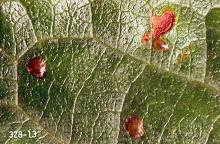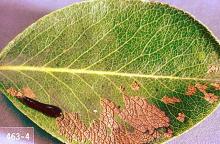California pear sawfly (Pristiphora abbreviata)
Pear slug (Caliroa cerasi)
Pest description and damage Pear slug is a European insect now found in most areas of the U.S. It attacks both pear and cherry and is found on rosaceous hosts. The adult is a glossy black wasp-like fly, about 0.2 inches in length. The larva initially resembles a small tadpole due to the olive-green slime that covers the body, and the head being wider than the rest of the body. Mature larvae are 0.38 inch in length and orange yellow. Larvae feed on the upper surface of leaves, skeletonizing them. Heavy feeding causes leaf drop, reduction in vigor and yield, particularly on young trees. California pear sawfly is found occasionally defoliating pear trees. Larvae eat round holes in leaves. After extensive feeding, only the midrib remains. The larvae are bright green, closely matching the leaf color; they rest along edges of the damaged area. This pest can severely defoliate ornamental pears.
For biology, life history, monitoring and management
See:
Pear, flowering (Pyrus)-Pear sawfly (pear slug)
Management-chemical control
See Table 2 in:




